Italian Demonstrative Adjectives – Quello Posted by Serena on Dec 20, 2016 in Grammar
In today’s exercise, we’re going to focus on the aggettivo dimostrativo ‘quello’ (demonstrative adjective ‘that’/’those’). As with the preposizioni articolate (see links below), the Italian aggettivo dimostrativo models its ending on the definite articles il, lo, la, i, gli, and le (the).
Let’s begin by looking at how demonstrative adjective correspond to definite articles. Then you can have a go at an exercise that requires you to fill in the blanks in the Italian text. You’ll find the answers hidden at the end of the blog.
il = masculine singular, e.g. il tavolo.
Corresponding demonstrative adjective ‘quel‘, e.g. quel tavolo (that table)
lo = masculine singular, used before ‘s’ plus a consonant, ‘z’, or a vowel, e.g. lo specchio, lo zaino. N.B. lo becomes l’ before a vowel, e.g. l’albero.
Corresponding demonstrative adjective ‘quello‘, e.g. quello specchio, or before a vowel quell’, e.g. quell’albero (that mirror, that tree)
la = feminine singular, e.g. la sedia. N.B. la becomes l’ before a vowel, e.g. l’arancia.
Corresponding demonstrative adjective ‘quella‘, e.g. quella sedia (that chair), or before a vowel quell’, e.g. quell’arancia (that orange).
i = masculine plural, e.g. i tavoli.
Corresponding demonstrative adjective ‘quei‘, e.g. quei tavoli (those tables)
gli = masculine plural, used before ‘s’ plus a consonant, ‘z’, or a vowel e.g. gli specchi, gli zaini, gli alberi.
Corresponding demonstrative adjective ‘quegli‘, e.g. quegli specchi (those mirrors)
le = feminine plural, e.g. le sedie.
Corresponding demonstrative adjective ‘quelle‘, e.g. quelle sedie (those chairs)

Geoff, guarda che bella livrea ha ___ mantide religiosa! A praying mantis attached to our front door. Photo by Geoff.
Exercise
Now fill in the gap in the Italian sentences with the correct aggettivo dimostrativo:
The book is on that shelf
Il libro è su ___ scaffale
That flower is a beautiful colour
___ fiore ha un colore bellissimo
Do you like those black shoes?
Ti piacciono ___ scarpe nere?
Mmm, those Amatriciana spaghetti were really delicious!
Mmm, ___ spaghetti all’Amatriciana erano davvero squisiti!
Look how many ripe persimmons there are on that tree over there!
Guarda quanti cachi maturi ci sono su ___ albero là!
How awful those buildings are!
Come sono brutti ___ palazzi!
“Where is the torch?” “I’ve put it inside that rucksack”
“Dov’è la torcia?” “L’ho messa in ___ zaino”
Geoff, look what a beautiful livery that praying mantis has!
Geoff, guarda che bella livrea ha ___ mantide religiosa!
That salad looks a bit wilted
___ insalata sembra un po’ appassita
Those olive trees are very old, their trunks are all twisted
___ ulivi sono vecchissimi, hanno il tronco tutto contorto
Are those oranges sweet?
Sono dolci ___ arance?
Can I have two hundred grams of those dates over there, please?
Posso avere due etti di ___ datteri lì, per piacere?
Click here to reveal the answers
The book is on that shelf
Il libro è su quello scaffale
That flower is a beautiful color
Quel fiore ha un colore bellissimo
Do you like those black shoes?
Ti piacciono quelle scarpe nere?
Mmm, those Amatriciana spaghetti were really delicious!
Mmm, quegli spaghetti all’Amatriciana erano davvero squisiti!
Look how many ripe persimmons there are on that tree over there!
Guarda quanti cachi maturi ci sono su quell’albero là!
How awful those buildings are!
Come sono brutti quei palazzi!
“Where is the torch?” “I’ve put it inside that rucksack”
“Dov’è la torcia?” “L’ho messa in quello zaino”
Geoff, look what a beautiful livery that praying mantis has got!
Geoff, guarda che bella livrea ha quella mantide religiosa!
That salad looks a bit wilted
Quell’insalata sembra un po’ appassita
Those olive trees are very old, their trunks are all twisted
Quegli ulivi sono vecchissimi, hanno il tronco tutto contorto
Are those oranges sweet?
Sono dolci quelle arance?
Can I have two hundred grams of those dates over there, please?
Posso avere due etti di quei datteri lì, per piacere?
N.B. If you’re browser or app doesn’t allow you to see the answers let me know and I’ll post them in the comments section.
Links to articles on the five main preposizioni articolate (preposition/article combinations):
Combining Prepositions With Articles – Part 1.
Combining Prepositions With Articles – Part 2.
Combining Prepositions With Articles – Part 3.

Build vocabulary, practice pronunciation, and more with Transparent Language Online. Available anytime, anywhere, on any device.




Comments:
Patricia:
E’bello fare esercizi ogni giorno non si dimentica le regole.
Joan Engelhaupt:
Confused again! If “quelle arance” is feminine plural, why isn’t “dolci” “dolce”?
Serena:
@Joan Engelhaupt Salve Joan!
‘Dolce’ is the singular form both in the masculine and feminine, and ‘dolci’ is the plural form, just like ‘grande, grandi’ (big), or ‘verde, verdi’ (green).
Saluti da Serena